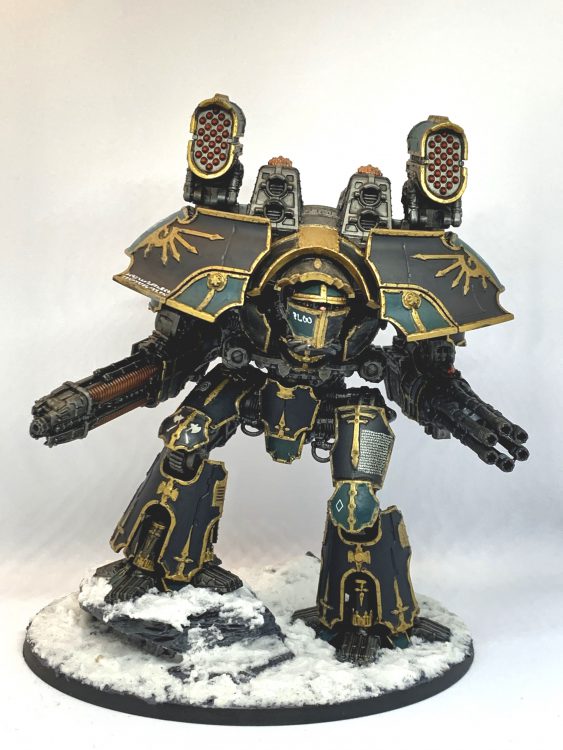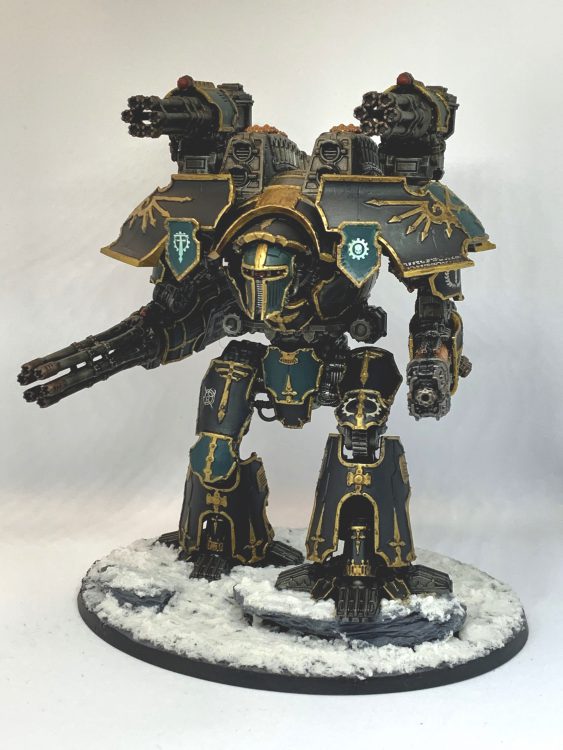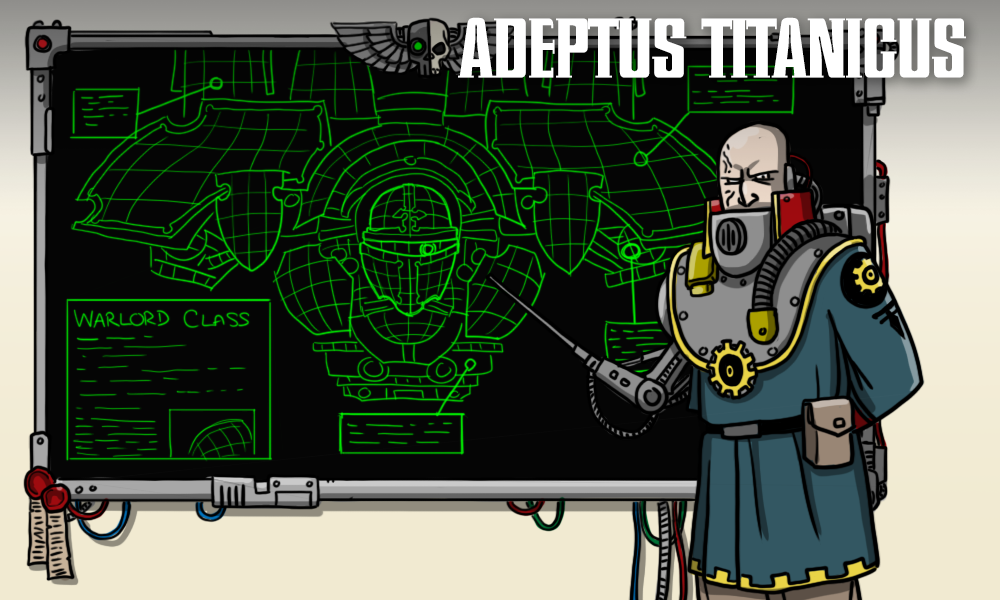Welcome back to Goonhammer’s series for aspiring Titan Principes. We here at Goonhammer’s own Collegia Titanica know that Adeptus Titanicus can seem intimidating to players unfamiliar with its particular quirks, but this series aims to equip you with everything you’ll need to play out epic clashes on the battlefields of the far future with your very own Titan Battlegroup. In this series, we’ll be taking a more in-depth look at the various Legios of the Collegia Titanica – exploring their origins and how to use them on the tabletop, from maniple selection and their loadouts, through to how to command them on the field of battle to secure ultimate victory.
This week, we’re looking at another Titan Legion released in Doom of Molech: Legio Vulcanum. This Legio is actually two legions that share a home Forge World and a High Gothic name – known in Low Gothic as the Dark Fire and the Lords of Ruin. Vulcanum is a very different Legion in many respects and plays drastically different than any other, trading activation advantage in the movement phase for overwhelming firepower in the combat phase, often mustering enough firepower to threaten an engine kill in a single activation before their enemies can react.
[Editors’ Note: This article was last updated November 22, 2021, and includes rules from the Loyalist Legios and Traitor Legios supplements, as well as the FAQ that accompanied the Loyalist Legios supplement.]

Who are Dark Fire and Lords of Ruin?
Legio Vulcanum differs from other members of the Collegia Titanica, starting with their name. The High Gothic “Vulcanum” refers to two Legios: Vulcanum I “Dark Fire” and Vulcanum II “Lords of Ruin”. Despite this, the two legions often fought together, cooperating with one another to destroy the enemy even as the competed to see which legion would ultimately take the glory of victory in battle.
This dual nature is reflected in both their lore and their rules in Titanicus. Unlike other legios, the princeps crews of both Vulcanum legions were usually clones with strong symbiotic ties to one another, which would lead to unfortunate results when one of them was slain in battle. These clones were created in batches on their homeworld of Stygies VIII, infamous in both the Warhammer 30K and Warhammer 40K settings for its long and storied history of pushing the acceptable boundaries of Imperial science, often into tech-heresy.
Vulcanum declared for the Warmaster with the outbreak of the Horus Heresy and took part in numerous campaigns, including the Doom of Molech.

Painting Legio Vulcanum
Legio Vulcanum have two slightly different colour schemes, both are primarily black with a gold trim, but one of the Legios is more a teal secondary colour whereas the other is more green. I’ve chosen to paint all of my engines so far in the teal scheme. I also build the entire model before applying any paint, but weapons are magnetised for ease of choice between games.
Paints used:
Games Workshop:
Chaos Black spray
Iron Warriors
Lupercal Green
Black Templar
Gryph Hound Orange
Mephiston Red
Mechanicum Standard Grey
Astrogranite Debris
Valhallan Blizzard
Spiritstone Red
Nuln Oil
Agrax Earthshade
DarkStar:
Regency Gold
Copper
Silver
Pewter
Scalecolour:
Oil works Grease
The Skeleton:
This is the simplest process. I prime the models with Citadel Chaos Black spray and then apply Iron Warriors to the skeleton of the model, followed by a shade of Nuln Oil. Drybrush back up with Iron Warriors and this stage is done. The lenses were done by painting two layers of DarkStar Silver and then a layer of Spiritstone red to give a glowing effect.
The Armour:
Since the armour is already sprayed with black, I simply went over this with Black Templar Contrast to even out the armour panels. The teal panels are done with Lupercal Green, two thinned layers over the black to achieve an even coat. The trim is painted with Regency Gold, which went on with one coat easily, thinned with a little bit of metallic thinner. A layer of oil wash Grease was then applied to the recesses and the gold trim.
Other Effects:
The lenses were done by painting two layers of DarkStar Silver and then a layer of Spiritstone red to give a glowing effect. The plasma glow on the plasma weapons are done by applying Pewter to the coils and adding a highlight of Silver on the top parts; Gryph Hound Orange is layered over the coils followed by the oil wash of Grease into the deepest recesses for more depth. The missiles are simply mephiston red with a nuln shade for depth. The void shield generators are done with Copper and shaded with Agrax Earthshade.
The Transfers:
Legio Vulcanum transfers don’t exist…yet anyway, so I used a mix of the transfers from various Titan sets, Knight transfer sheets, and some Word Bearer transfers for the runic text and symbols. These were applied with decal softener from Green Stuff World and then Decal Fixer, followed by matt varnish. To make these appear more set-in to the armour I went over the transfers on black armour with Nuln Oil, and the ones on the teal armour with a thinned Lupercal Green to make it shade-consistency.
The Bases:
I wanted something to contrast the very dark colour scheme. I used chunks of slate on the bases for the rocks and painted over these with Mechanicum Standard Grey and shaded with nuln oil. A layer of Astrogranite Debris was put on the bases to add texture before the snow and then a hefty amount of Valhallan Blizzard added on top.

Vulcanum in Adeptus Titanicus
Almost all of both Dark Fire and Lords of Ruin turned Traitor when the Warmaster’s call came down, honoring the bonds they had forged with the Warmaster and his forces during the Great Crusade. They bring a unique bag of tricks to the tabletop in Titanicus that can be difficult to use, but very rewarding once you get the hang of it.
Tactical Overview
Vulcanum plays very differently than most other Titan Legions in a few very specific ways. Their first Legio Trait, Two-Faced God allows two Vulcanum Titans from the same Battlegroup to have a Princeps Seniores instead of only one per maniple. However, if one of them is killed, the other’s Princeps is wounded, and this effect cannot be repaired. For the Fallen, their other Legio Trait, grants every Vulcanum Titan one re-roll per turn for each other Vulcanum Titan that has been destroyed. This re-roll is incredibly useful in the mid-to-late game, since while we’d all like it if our Engines didn’t die, losing one or two over the course of the game is inevitable. And with how hard re-rolls are to come by in Titanicus, this is a powerful effect that will help you come back from an early loss.
They have one legion-specific stratagem, Symbiotic Commands, which allows you to automatically issue the same order to each Vulcanum Titan in your battlegroup with a single command check. At 1 stratagem point, this could be a clever way to get the most out of a force that is built toward a single goal. You won’t always take this, but if your list wants to be issuing identical orders to multiple Titans at once, it’s worth considering.
Bair: The best use for this I see is in a Corsair Maniple, since Corsairs so often want to go on Split Fire orders. Issuing this to one of your two Princeps Seniores on a 2+ and then granting it to the rest of your Reavers would be beneficial.
Now, where Vulcanum really gets interesting is in their two legion-specific upgrades. First off is Twinned Machine Spirits, which costs two Titans 20 points each, and pairs them together to form a squadron of two. This can be any two Titans, regardless of whether they could normally join a squadron. This means you could squad together two Reavers, a Reaver and a Warbringer, a Warhound and a Warlord, or even two Warlords. There’s a catch, though: whenever one of the twins rolls an Awakened Machine Spirit result on the Reactor die, both of the Engines have to roll a command check. This can be incredibly powerful: a twinned pair of Reavers making a coordinated strike against their target can be incredibly deadly. You can strip shields with one, then hit hard with the second before the enemy gets to activate in between. With some smart positioning and clever play, this can enable powerful alpha strikes that can net you an early engine kill. The downside, of course, is losing an activation. This means that your opponent will be able to see where you’ve moved before moving most of their battlegroup, allowing them to get an advantageous position and dodge your firing arcs. One way around this is to take a few Knight banners to pad out your activation count. Pairs of Lancers are a solid choice as they’re fast, fairly durable, and present a real threat to the enemy on the charge, all while clocking in at less than 200 points.
Their second upgrade, Janus Pattern Missiles, adds more depth and flexibility and speeds up the process of stripping your opponent’s shields. At an additional 20 points onto a Reaver or Warlord’s apocalypse missile launchers, this isn’t a cheap upgrade. However, it allows a Vulcanum Titan to split its AML’s shots between its main target and any other enemy within 12” of the main target, assuming you have line of sight and range (and since it’s an Apocalypse launcher, you will have range). Using these on a twinned set of Reavers or Warlords lets you fire the first twin’s missiles into a target’s voids, then direct any excess shots from the second twin’s missiles into a new target while you go full in with those melta cannon and Sunfury shots to the main target whose shields just dropped.
As far as the Princeps Seniores Traits, none stick out as all too interesting compared to the main rulebook, unfortunately. True Born adds +3 to all command checks made by the Seniores to issue orders instead of the usual +2, but if you do roll a 1 on their command check, none of the Titans in the Vulcanum player’s battlegroup may be issued any more orders. Other rules don’t affect this, and it sticks even if you re-roll the check. Even worse, as written, this rule appears to stop your Battlegroup from issuing more orders for the rest of the game, not just that turn.
Divided of Mind allows the Princeps to re-roll the check to issue a command however if the re-roll also fails then all orders on all Titans within the same maniple are removed (except for emergency repair orders). If you’ve got this on a Warlord or Reaver that isn’t Corrupted (so is issuing on a 2+) then it’s a nice way to add some reliability to your orders with very little risk.
War’s Orphan lets the Seniores push the Titan’s reactor even when on the Red reactor status mark, however causing 1 S9 hit to the body per time the reactor would advance. It’s an interesting choice, but one that will usually just lead to the Titan blowing itself up.
Condit: There is a somewhat unusual use for this in a Regia: nominate a pair of Warhounds (not Warlords) to get personal traits and give them both War’s Orphan, then use their ability to push past to continue to get re-rolls on the Warlord’s shields even if their reactor track is at the end, keeping the Warlord alive. Then, when you’re close enough for the Warhounds to move in, push for movement to ensure you’re redlining and hope they go out with a bang in the middle of your opponent’s force.

Maniple Choice
There are a few maniples that are particularly interesting as Vulcanum. My two favorites and big winners are Regia and Ferrox. A Vulcanum Ferrox can fit a couple small banners of Knights alongside paired Reavers and Warhounds, helping Vulcanum in a massive way by padding out their activation count and preventing them from running a two activation list at 1500 points. A Ruptura Maniple with paired Warbringers could be devastating, being able to share shields in the backfield and having that much more chance of causing Catastrophic damage thanks to Coordinated Strikes, which would result in free movement for the Reavers.
However, if you’re looking for the iconic Vulcanum battlegroup, look no further than the Regia Battleline Maniple. Incredibly hard to kill, it allows the Warhounds to share shields with the Warlords so long as they’re within 3”. However, it is definitely an unwieldy maniple, especially when Vulcanum takes it, so might not be a great pick for new players. The aforementioned Ferrox Light would be significantly easier for a beginning player while you’re still getting to grips with the legion’s unique rules and unorthodox playstyle.
Legio Vulcanum Battlegroup – 1750 pts
Regia Maniple
Warlord Titan 1 – 540 pts
- Princeps Seniores – Ironclad Tyrant
- Apocalypse Missile Launchers – Janus Pattern Missiles
- Sunfury Plasma Annihilator
- Macro Gatling Blaser
- Twinned Machine Spirits – with other Warlord
Warlord Titan 2 – 540 pts
- Princeps Seniores – Dominant Strategist
- Apocalypse Missile Launchers – Janus Pattern Missiles
- Sunfury Plasma Annihilator
- Macro Gatling Blaser
- Twinned Machine Spirits – with other Warlord
Warhound Titan 1 – 220 pts
- Turbo Laser Destructor
- Vulcan Mega-Bolter
- Bastion Shielding
Warhound Titan 2 – 220 pts
- Turbo Laser Destructor
- Vulcan Mega-Bolter
- Bastion Shielding
Warhound Titan 3 – 230 pts
-
- Plasma Blastgun
- Vulcan Mega-Bolter
- Bastion Shielding
This list is weird, but it’s what Bair has been running with some success because of how hard to crack it is until the enemies get close. The Warlords are paired together with Twinned Machine Spirits, and the Warhounds are in one big squadron, leaving you with a whopping 2 activations in total. The Warlords are also making use of the Two-Faced God legion trait, allowing them each to take a personal trait. We’ve given one of them the Dominant Strategist trait so it can take the Opus at a critical moment, allowing for a powerful alpha strike with the twinned Warlords, and gave the other Ironclad Tyrant which gives it one re-roll per turn for an order after failing a command check, making sure the list is getting the orders off that it needs when it needs them. Bastion Shielding on the Warhounds takes survivability 1 step further giving the Battlegroup more re-rolls on shield saves without going into Orange heat on the Warhounds.
Paired Warlords means two things: they stand side by side to share their void shields together thanks to Twinned Machine Spirits (and with the Warhounds thanks to the Regia’s maniple trait), but even more importantly, they’re making coordinated strikes at their targets, making each of their weapons that much more deadly with +1 to armour rolls. One of the points of this list is the Warhound with double lasers, not something we’d often run, but when the Warhound is acting primarily as a void shield battery for Warlords, that Titan is not moving very far very fast, so the extra range on the weapons comes in handy. A few extra shots in the first turn can be very important, especially when they can benefit from the Shieldbane trait to help take shields off so that the Warlords can really lay into an enemy target. Generally speaking, depending on terrain set up and any other active stratagems, this list wants to deploy with the Warlords in the middle and one Warhound either side/slightly in front of them for a maximum amount of shields to share around between them all.
There are a number of stratagems that can be an effective use of the 5 stratagem points you’ll generally have with this list. Warmaster’s Portion gives re-rolls in the first game turn, and depending on what the enemy is running, you may be able to get your weapons in range to fire turn 1, making great use of the re-rolls to hit. Gifts of the Dark Mechanicum, while expensive, can be very useful on the turbo-laser Warhound: being able to push for Shieldbane on both guns turn 1 and then push again for Shieldbane turn two or get a free Voids to Full! or two when you need it can be extremely useful when you’re wanting to keep your maniple’s shields at 3+ re-rolling 1’s for as long as possible. While this is expensive at 3 Stratagem Points, it can really come in handy and drastically increase the effectiveness of your list. If the enemy is fielding a Warlord with shorter ranged weapons, especially a “Brawler” Lord, consider Dark Pledge, a cheap stratagem that can yield a large number of victory points – and with paired Warlords firing at it, any target should go down relatively quickly. Thermal Mines is almost always a fantastic choice, this has the potential (though not an extraordinarily likely one) to kill a Warhound, and at the very least will usually cause some serious damage to its legs. It’s also great to use against a Reaver Titan with a melee weapon trying to close the gap as it can seriously slow them down and make your opponent think more seriously about how they want to use their repair dice if you can strip some shields before they’re able to repair any damage caused. [Condit: I’m still a little mad.] It might also pair well with Shock Mines. This combo would use all 5 of your stratagem points (assuming you have that many to spend), but with some damage caused by the thermal mines first, it could cause a shutdown on an enemy titan, leaving it with no shields and no guns to fire for that turn. Finally, Vox Blackout is a cheap stratagem that is always worth considering if other strats haven’t eaten all your points. In our opinion, it’s one of the best 1-point stratagems you can take as Vulcanum, allowing you to deny your opponent an artillery bombardment for the turn, and preventing them from issuing any orders, which can come in handy when they get near enough for charges.

Playing Against Vulcanum
The major drawbacks most Vulcanum lists is the small number of activations, making it far easier for you to move out of the corridor arc of Warlords, move into their side and rear position, and otherwise gain positional advantage once you know where your opponent’s Titans are at. Leverage your activation advantage to get the best position you can.
Vulcanum lists also often want to stay very close together to take advantage of Twinned Machine Spirits, so artillery stratagems and blast weapons can be particularly effective. Quake Shells is one of the deadliest stratagems that can be taken against Vulcanum since it’s likely to hit at least one of the Titans, potentially causing collisions and knocking them out of shield-sharing range, messing up plans for First Fire or Emergency Repair orders.
Focusing down one of the two engines with Two-Faced God is also devastating for the Vulcanum player, causing their other Titan to be permanently unable to take any order, and giving them a chance to shut down every turn. It’s not extremely likely – with the re-roll it’s a 1/36 chance – but when it comes up it can be utterly devastating. If you get the chance to take out one of their princeps, take the shot.

Two Faces Are Better Than One
Vulcanum are definitely one of the stranger Legios to play, with their panoply of rules that significantly change how you make use of your Titans. However, there are a variety of ways to be able to field them effectively, and being able to pair two of any engine gives you a lot of choices in how to build and play your list. While building a Vulcanum list isn’t without its drawbacks, with some foresight, smart play, and a little luck, you can pull together these twin legions to pose a serious threat to anyone who would dare stand before you.
As always, if you have any questions or feedback, feel free to drop us a note in the comments below or email us at contact@goonhammer.com.



You must be logged in to post a comment.